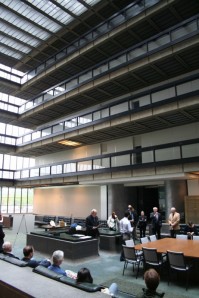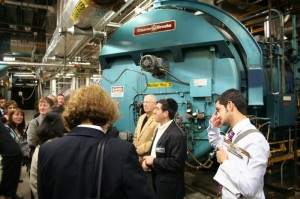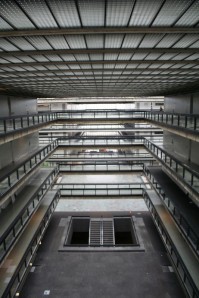July 20, 2009
Reading Time: 5 minutesBells Labs, Architecturally Significant Modernist Building in Holmdel, N.J.

Peter C. Papademetriou, an expert on Finnish-American architect Eero Saarinen, who designed the Bell Labs building in Holmdel, N.J., delivers a presentation on Saarinen to architects in the atrium of the modernist landmark.
The group of about 60 architects attended a tour sponsored by the Emerging Professionals program of the Newark and Suburban section of the New Jersey chapter of the American Institute of Architects (AIA-NJ). The tour included presentations by Saarinen expert Peter C. Papademetriou, and Ralph Zucker, president of Lakewood, N.J.-based Somerset Development, the contract purchaser for the building.
“It’s immense compared to what I thought it would be,” said self-confessed Saarinen fan Elizabeth Drake, AIA, principal of Elizabeth Drake Architect in Cedar Knolls, N.J.
The modernist landmark, which was completed in 1962 and expanded in 1966 and 1982, is considered the state’s most important example of post-World War II modernist architecture. It was closed in July 2006 and listed for sale by owner Alcatel-Lucent. The site was named to Preservation New Jersey’s list of the “10 Most Endangered Historic Sites in New Jersey” that same year.
The tour was part of an ongoing effort by AIA-NJ to call attention to the architectural significance of the building and the need to preserve it.

Ralph Zucker (center), president of Somerset Development, the contract purchaser for Bell Labs, tours the building with a group of architects from AIA-NJ. Ricardo Soares (right), AIA, LEEDap, chaired the event.
“Bell Labs is symbolic of an era of great corporate headquarters that housed thousands of people under one roof,” said Ricardo Soares, AIA, LEEDap, who chaired the event. “But even more important is the role of the building — as well as Saarinen’s other works, such as the Gateway Arch in St. Louis and the TWA terminal at JFK — as representative of the genius of the architect. In preserving Bell Labs, we are preserving a piece of art.”
AIA-NJ’s efforts to preserve the building go back more than a year to a three-day multidisciplinary charrette (a collaborative design session) held in April 2008 by a group of organizations including AIA-NJ that developed approaches for the preservation and sympathetic and sustainable reuse of the building. The charrette report, published the following December, recently won a state historic preservation award (http://www.state.nj.us/dep/hpo/4sustain/awds2009.htm#awd8) .
Zucker credited the charrette report with reaffirming his vision for the property and with guiding the company in its formation of a preservationist approach to its redevelopment. The property had previously been considered too difficult to preserve, and earlier plans had called for demolishing most of the huge structure and replacing it with smaller office buildings and single-family homes.
During the tour, Zucker presented his company’s conceptual plans for the property, which include preserving the building and the equally significant landscape design by Sasaski, Walker and Associates and adapting it for retail, office, hotel/conference center and residential uses.
“We were very influenced by the charrette,” Zucker said. “One of the reasons we became involved was because of the charrette’s vision, which demonstrated that the building has great flexibility. Almost anything you want to do with it will work.”

The Atrium of the Bell Labs building in Holmdel, N.J.
“Saarinen used a heterodox visual language that spanned a range of possibilities when everyone else was fitting in a package,” Papademetriou said. He went on to quote architect Robert Venturi, FAIA, on Saarinen: “‘With everyone else you could tell what they were going to do, but with Saarinen’s office, you never knew.'”
In addition to their awe at the grandeur and innovative nature of the design, however, the architects also reported feeling sombered by the sight of what they viewed as a melancholy monument to a bygone century of American technological supremacy.
The list of technological wonders developed at Bell Labs is breathtaking, including data networking, the transistor, cellular telephone technology, solar cells, the laser, digital transmission and switching, communications satellites and microwave transmission. The “Big Bang” theory of the origin universe was confirmed there by Bell Labs scientists who discovered the cosmic background radiation supporting the theory.
Also of interest to the architects were accounts of life in the building provided by James Canham, who was the facilities manager for 17 years. Canham reported that the building was so large that it had its own micro-climate, telephone exchange, post office, bank, dry cleaner, medical staff and fire department. He also told of scientists who liked to launch paper airplanes from the railings of the corridors into the vast open space of the atrium.
The architects asked many questions but one in particular perplexed them: Why had such an inspiring building — a building that played such an important role in the history of American technology — been allowed to fall vacant?
The answer, Zucker said, is that so few people are familiar with it. Set back from the road at the center of a 472-acre campus, it was nearly invisible to passersby. With AIA-NJ’s award-winning charrette, however — and now with the architects’ tour — AIA-NJ is working to build a constituency of support for the preservation of one of the state’s most significant architectural masterpieces, as is Somerset Development with a design that will open up the structure, and “invite the community in,” as Zucker put it.
“The building may be empty, but it’s not dead,” observed Christopher J. Gnash, AIA, director of architecture for the Morris Companies in Rutherford, N.J., upon touring the humming boiler room. “Its heart is beating.”
The tour is one of several building tours held each year by the AIA Newark and Suburban section’s Emerging Professionals program. The next tour will be held later this summer at a site to be determined. For more information, visit the AIA-NJ Web site at http://aianj.wpengine.com. The Bell Labs charrette is also available for download from the AIA-NJ Web site.
By WeSpeak Easy | Posted in AIA-NJ News, Emerging Professionals, Members & the Community | Tagged: AIA-NS, bell_labs, Saarinen | Comments (0)
Architects are creative professionals, educated, trained, and experienced in the art and science of building design, and licensed to practice architecture. Their designs respond to client needs, wants and vision, protect public safety, provide economic value, are innovative, inspire and contribute positively to the community and the environment.

414 Riverview Plaza, Trenton, NJ 08611
(609) 393-5690
info@aia-nj.org